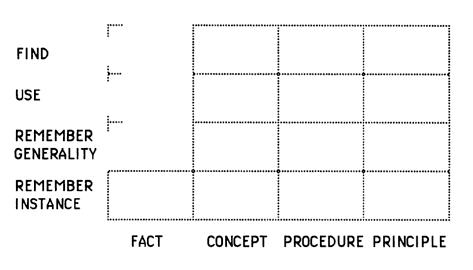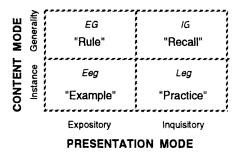Sadržaj
Component Display Theory
General
Component display theory is one of the cognitivist instructional design models introduced by Dave Merrill in the 1980s, whose original intention was to separate content from instructional strategy. Component display theory was greatly influenced by Robert Gagne's conditions of learning. In his own words,
- “Component Display Theory was an attempt to identify the components from which instructional strategies could be constructed.”1)
Aside from identifying those components, Merrill suggested their usage in order to create successful instructions.
What is component display theory?
Influenced by Robert Gagne's theory of conditions of learning, Merrill agreed that different learning outcomes require different learning strategies, and his idea therefore was to suggest learning strategies according to target content and performance. Merrill suggested four different categories of content2):
- facts (“arbitrarily associated pieces of information”)
- concepts (“a set of objects, events, or symbols with shared common characteristics”),
- procedures (“an ordered sequence of steps necessary for the learner to accomplish some goal”), and
- principles (“or predictions of why things happen in the world”),
and three different categories of desired performance3):
- remember (“search memory in order to reproduce or recognize some item of information previously known”),
- generality (“a statement of a definition, principle or the steps in a procedure”)
- instance (“specific illustration of an object, symbol, event, process or procedure”)
- use (“apply a generality to a specific case”), and
- find (“derive or invent a new abstraction”).
The performance-content matrix is used to identify learning objectives. Each of the matrix fields presents one possible arrangement of learning content and target performance. For example, objective to teach a student to memorize facts and dates referring to First World War refers to the remember instance/facts field in the matrix, and objective to teach a student to identify humanist ideas in paintings of renaissance artists refers to the find/concept field.
Each so defined learning objective is further characterized by three components: conditions, behavior and criterion. Merrill constructed tables addressing these components for each of the mentioned matrix fields (Still in the mentioned tables he did not distinguish between two types of remembering mentioned above). An example row from the table4) looks like this:
An example of interpretation is following:
- (Under conditions when/If) given pictures/drawings (column 1)
- of/referring to unspecified categories (column 2),
- student will (behave to) invent categories (column 3)
- by observing, specifying and sorting attributes (column 4),
- with no time limits, but high correlation when others use concept (column 5),
- which will be shown by - (column 6).
Now when the learning objective is fully defined, a learning presentation should be designed. According to Merrill, all cognitive matter can and should be presented as a sequence of discrete presentations composed out of primary and secondary presentation forms. Primary presentation forms are:
- expository5) presentation of a generality (rules, EG)
- expository presentation of instances (examples, Eeg)
- inquisitory6) generalities (recall, IG)
- inquisitory instances (practice, Leg)
Merrill's secondary presentation forms, added in order to enhance learning, facilitate information processing and add context, include prerequisites objectives, helps, mnemonics and feedback.
A successful instructional design should include both primary and secondary presentation forms. Fundamental elements of all four types of primary presentation forms based on the content type which should be learned are suggested by Merrill7). He also describes them in more details and recommends them on practical examples of a simple computer application for learning. While doing that, he keeps in mind that “one of the primary functions of instruction is to promote and guide active mental processing on the part of the student” and that the learner should also be provided with a number of examples he wants.
Criticisms
A number of limitations of component display theory were described by Merrill himself8):
- Content analysis focuses on (micro) components, rather than integrated wholes. Each phase of instructional development is performed independently of other phases.
- It does not really address the issues of knowledge acquisition.
- The resulting instruction often remains passive and teaches components but not integrated knowledge and skills.
- An instructional designer must build every presentation from fundamental components.
Other criticisms include lack of empirical evidence on connections between internal processes and external events, too little explanations on internal processes, and lack of category for complex learning of problem-solving9). In the late 1980s Merrill introduced his reconsiderations of the componend display theory named component design theory.
Keywords and most important names
- Component display theory, categories of content, categories of desired performance, performance-content matrix, primary/secondary presentation forms
Bibliography
Learning and ID: Cognitive Apprenticeship and Component Display Theory. Learning and Instructional Design Wiki. Retrieved: 10. March 2011.
Ho, Wenyi. Merrill's Component Display Theory (CDT). Penn State University. Retrieved: 10. March 2011.
An Atomic Meme wiki: Component display theory - eLearning snippets. Retrieved: 9. March 2011.


